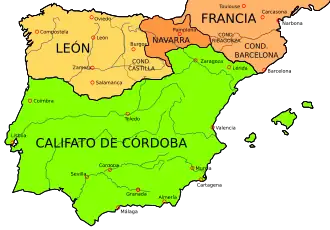Battle of Alcalá de Henares
| Battle of Alcalá de Henares | |||||||
|---|---|---|---|---|---|---|---|
| Part of Fitna of al-Andalus | |||||||
 The Iberian Peninsula in 1000 AD | |||||||
| |||||||
| Belligerents | |||||||
|
Berbers County of Castile | Caliphate of Córdoba | ||||||
| Commanders and leaders | |||||||
|
Sulayman ibn al-Hakam Sancho García of Castile Zawi ibn Ziri | Wadih al-Siqlabi | ||||||
| Casualties and losses | |||||||
| Unknown | Unknown | ||||||
The Battle of Alcalá de Henares (August 1009),[1] was a battle of the Fitna of al-Andalus that took place in Alcalá de Henares near Madrid , between the Middle March's forces of the Caliphate of Córdoba under general Wadih al-Siqlabi against the allied Berber-Castilian forces supporting Sulayman ibn al-Hakam's rebellion against Caliph Muhammad II of Córdoba. The battle ended with a victory for the Berbers and the Castilians, forcing Wadih al-Siqlabi to retreat to Córdoba and join force with Muhammad II of Córdoba.[2][3][4][1]
Background
Muhammad II of Córdoba rose in rebellion against Caliph Hisham II and deposed him from the throne, Muhammad became Caliph and managed to oppress the Berbers in Córdoba with the backing of the citizens. Berbers were forced to leave the city after fierce fighting, they found an Umayyad member called Sulayman ibn al-Hakam and choose him as their candidate to the throne of the Caliphate of Córdoba, they promised him the Caliphate and gave him the title "Al-Musta'in bi-Allah" (he who implores the assistance of God).[3][2]
The Berbers captured Calatrava and Guadalajara with ease but were refused by Wadih al-Siqlabi governor of the Middle March when they tried to enter the Medinaceli region, Berbers were low on resources that they had to eat plants for fifteen days until they could take no more of it, they sought help from the Count of Castile, Sancho García of Castile, Wadih al-Siqlabi also sent ambassadors to Castile, Sancho García decided in favor of Sulayman ibn al-Hakam and the Berbers, he supplied them with sheeps and coal, honey and firewoods, horse saddles and clothing.[2]
Battle
Sancho García of Castile joined forces with Sulayman ibn al-Hakam and marched to Medinaceli where they unsuccessfully tried to convince Wadih al-Siqlabi to join them and accept Sulayman ibn al-Hakam as the legetiment Caliph,[3][2] Muhammad II of Córdoba sent reinforcements to his loyal governor of the Central March,[2] Wadih al-Siqlabi then attacked Sancho and Sulayman with full army of the Middle March near Alcalá de Henares, where he was decisively defeated,[2][3][4][1] he then managed to flee and join Muhammad II of Córdoba in the capital of the caliphate. Berbers captured those who were with Wadih, they killed whom they liked and pardoned whom they liked, they put the heads of the slain ones on top of Alcalá de Henares.[1]
Aftermath
Sulayman ibn al-Hakam continued the advance on Córdoba where in the way, confronted Muhammad II of Córdoba and Wadih al-Siqlabi at the Battle of Qantish where he was victorious resulting in his rise to the throne and installment as Caliph on 8 November 1009 by Zawi ibn Ziri a prominent berber commander and supporter of Sulayman,[5][6] Wadih and Muhammad retreated to Toledo.[7]
References
- ^ a b c d Smith, Colin; Melville, Charles Peter; ʻUbaydlī, Aḥmad (1988). Christians and Moors in Spain. Oxford University Press. ISBN 978-0-85668-450-0.
- ^ a b c d e f Scales, Peter C. (1993-12-31). The Fall of the Caliphate of Córdoba: Berbers and Andalusis in Conflict. BRILL. ISBN 978-90-04-09868-8.
- ^ a b c d Flood, Timothy M. (2018-11-09). Rulers and Realms in Medieval Iberia, 711-1492. McFarland. ISBN 978-1-4766-3372-5.
- ^ a b Ygua, Ruben (2025-04-10). THE CHURCH IN CHECK. Ruben Ygua.
- ^ Amabe, Fukuzo (2016-04-18). Urban Autonomy in Medieval Islam: Damascus, Aleppo, Cordoba, Toledo, Valencia and Tunis. BRILL. ISBN 978-90-04-31598-3.
- ^ Smith, Colin; Melville, Charles Peter; ʻUbaydlī, Aḥmad (1988). Christians and Moors in Spain. Oxford University Press. ISBN 978-0-85668-450-0.
- ^ Flood, Timothy M. (2018-11-09). Rulers and Realms in Medieval Iberia, 711-1492. McFarland. ISBN 978-1-4766-3372-5.